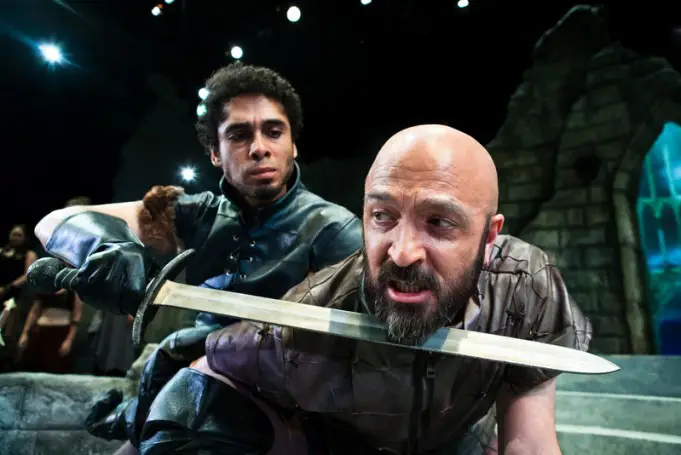With a stunning My Fair Lady behind them, SF Playhouse brings us another Lerner and Lowe production, and returns Charles Dean, Monique Hafen, and Johnny Moreno to the stage. The same strengths these three brought to Lady, they also bring to Camelot.
Once again Bill English reimagines the original production and brings us a very different show than the admittedly delicious spun sugar confection that was the Broadway Camelot. In doing this, he brings the story closer to both the T.H.White book from which Camelot is drawn – and to the historical Arthur.
While historians don’t agree whether Arthur really existed, they do agree that his reign would have been after the Romans left Britain, and well before 1136, when Geoffrey of Monmouth penned his Historia Regum Britanniae (History of the Kings of Britain). These years were called the dark ages for a reason: Angles, Saxons, Jutes and Danes struggled for control of the Isle and were locked in nearly perpetual combat. The SF Playhouse version, with its knife’s edge violence at the surface, comes closer to giving a feel for this period – further illustrating why the Arthurian ideal was so important – and so improbable.
Trading the Broadway artifice for historical accuracy helps make this play a rare animal
Gone are the knights in shining armor and romanticized costumes, appropriate only to a mores genteel age. While later notions of chivalry (an idea that didn’t exist until the 12th century) still govern relations between Guinevere and Lancelot, Arthur fans will appreciate the inclusion of “Fie on Goodness, Fie,” (which was eliminated from the Broadway production), which better characterizes this period. English also expanded Mordred’s role, which is welcome because this character is the engine that drives the story forward. Paris Hunter Paul makes a deliciously evil Mordred, capturing perfectly the manipulative swine found in the T.H. White book.
FOLLOW: SF Playhouse news, reviews, videos
Trading the Broadway artifice for historical accuracy helps make this play that rare animal – one in which the second act was stronger that the first. Unlike the Broadway production, this second act emphasizes the Arthurian tragedy.

Charles Dean appears briefly Merlin, and again as the aging King Pellinore. Given that his lifelong mission is to traipse through the elements and track the questing beast, Pellinore can be one of the sillier characters. However, Dean’s Pellinore is one of the noble, albeit uncomplicated sort, unmuddied by with mixed loyalties. The same clarity of motivation and all-around likeablity that he brought to Doolitle, Dean invests in Pellinore.
Hafen’s role as Guineive was more complicated. English tries to convey Guinevere’s frustration at being little more than a chattel in a game not of her own making. Fortunately, in Hafen’s hands, this attempt fails. Her role is consistent with the T.H. White book. The bottom line is she’s a silly girl, with enormous power, but not the wisdom to use it. Hafen serves the role well, maintaining the audience’s sympathies for this rather silly twit. However, when she’s shipped off to the convent at the end, our sympathies are with Arthur for the loss of his wife, rather than for any fate that’s befallen Guinevere.
ALSO SEE: He’s the Man: Don Reed and East 14th
Johnny Moreno brings us a nuanced Arthur, who we watch evolve from a callow, over-enthusiastic youth, to a young and hesitant king, to an older and chastened Arthur who sacrifices his wife and best friend to his loyalty. Moreno conveys more a sideways look and a nanosecond pause that many do with reams of text.
My only quibble with this show was with the set. This was an exquisite set, one that I wanted to climb over and feel for myself. The rotating castle elements worked beautifully together and were perfectly integrated with the video projections. However, I couldn’t get past the nagging question why the castle was demolished from the very beginning – and why it remained so – and why Arthur lived in a castle even drearier place than the one in which is spent his youth. Given that English spent so much time getting it right, this question dogged me throughout the show.
Camelot plays through September 21st.



